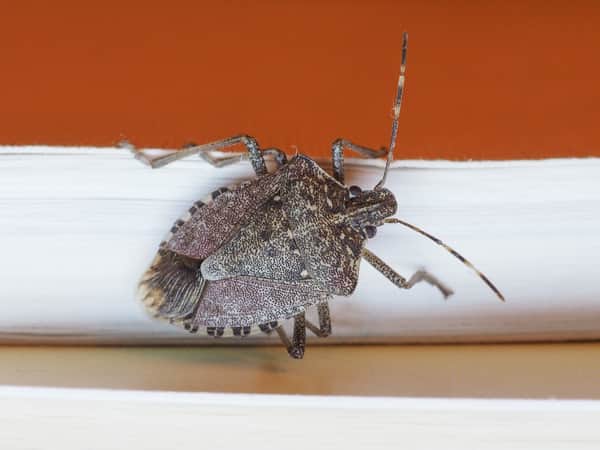
There are many different types of stink bugs found throughout the world. These insects are named for the foul odor they emit from glands in their abdomen when they feel threatened. They are sometimes referred to as the ‟shield bug” because of the shield-like, triangular shape of their body. Many types of stink bugs are considered little more than a nuisance pest, but some species can cause major damage to produce and other agricultural crops.
In general, stink bugs mate during the spring and spend the winter months in sheltered areas. The females can produce 30 to 100 eggs at one time, and as many as 400 baby stink bugs in their lifetime. Stink bug eggs are usually deposited on the underside of host plants.
Learning about different types of stink bugs will help you understand why they may be present in your home or garden. Below is some information on the most common species that you may encounter.
Brown marmorated stink bugs
This type of stink bug is one of the most common found in the United States. Native to China, Japan and Taiwan, this species is believed to have been accidentally introduced into the U. S. in 1998. This stink bug has a triangular-shaped body and is distinguished from other stink bugs by its color. It has a brown-colored body, dark brown lower wings and lighter colored antennae. Brown marmorated stink bugs are considered agricultural pests because they feed on many different types of fruits, soy beans, green beans and ornamental plants.
Harlequin bugs
The harlequin bug is found from coast-to-coast in the U. S., but is rarely seen north of the area from Colorado to Pennsylvania. This species is identified by spotted colors of red and black on their flat, long, shield-shaped body. They are known to eat cauliflower, cabbage, turnips, collards and horseradish. If left uncontrolled, they can destroy entire crops.
Southern green stink bugs
This stink bug type is found primarily in Alabama, Mississippi, Louisiana, Florida, Georgia, Texas, Virginia, California and Hawaii. They are green in color with either red or black eyes. They also have black dots on the sides of their abdomens. These pests feed on growing plant shoots and developing fruits. Affected plant shoots will die, while fruits will show brown or black spots. Developing fruit that is infected will wilt and drop from the plant.
Rice stink bugs
These stink bugs are found in a variety of areas, from east of the Rocky Mountains to Minnesota and New York. They are also common in the Southeastern states. Rice stink bugs are a golden color and have forward-pointing spines on their body. As their name would indicate, rice plants are the food of choice for these pests. However, they also feed on sorghum and other plant grasses.
Forest bugs
Stink bug types, such as the forest bug, are found in woodland areas worldwide. They are easily identified by their brown body that has reddish and orange markings. They are triangular-shaped and have orange legs. Forest bugs use their piercing mouthparts to feed on the sap of many different types of oak trees. In addition, they will feed on nut bearing trees and fruit. Sometimes, they also feed on other insects.
Beneficial stink bugs
Some types of stink bugs are beneficial in that they prey on other insects that can be damaging to agriculture. For example, the spined soldier bug is a type of stink bug that eats caterpillars and insects such as the Mexican bean weevil that causes damage to crops and garden plants. Indigenous to North America, spined soldier bugs are light brown, beige or yellow in color, with black spots on their body. They have protruding ridges on the upper side of their body and on the back of their head.
Another stink bug of agricultural importance is the two-spotted stink bug. Their body is orange and black with two distinct black spots on top of their thorax. They also have a bell-shaped pattern on top of their back. This stink bug is a predator of the Colorado potato weevil and is found throughout the Northwest.
Just the name ‟stink bug” alone is enough to give cause for alarm. No matter what types of stink bugs are attempting to smell up your home, call the pest management professionals at Terminix® for assistance.

